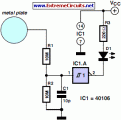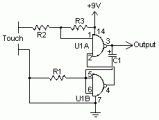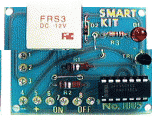FREE
circuits!
Touch sensor circuit diagrams
- 1
- 2
December 27, 2010
The circuits light a 20 watt lamp when the contacts are touched and the skin resistance is about 2 Megs or less. The circuit on the left uses a power MOSFET which turns on when... [more]
November 25, 2010
The purpose of this circuit is to animate shop-windows by means of a capacitive sensor placed behind a post-card-like banner. [more]
September 30, 2010
The modern mechanic switches are improved concerning of old technology. We need however many times to replacement some old switch or to check currents bigger than the durability of certain switches or simple we need... [more]
circuit from:http://www.extremecircuits.net/2009/08/on-off-touch-switch-circuit.html
September 27, 2010
This simple circuit can be used to activate whatever you like, for example, by connecting it to microcontroller, relays, secret alarms, robot applications or just turn on LED1 which lights up as long as you... [more]
circuit from:http://www.extremecircuits.net/2010/05/simple-one-wire-touch-detector.html
September 27, 2010
The purpose of this circuit is to animate shop-windows by means of a capacitive sensor placed behind a post-card-like banner. The card is placed against the glass inside the shop-window, and the visitor can activate... [more]
September 27, 2010
Capacitive touch sensors are based on the electrical capacitance of the human body. When, for example, a finger comes close to the sensor, it creates a capacitance to Earth with a value of 30 to... [more]
circuit from:http://www.extremecircuits.net/2010/05/simple-capacitive-touch-sensor.html

July 3, 2010
A touch switch is a switch that is turned on and off by touching a wire contact, instead of flicking a lever like a regular switch. Touch switches have no mechanical parts to wear out,... [more]

July 3, 2010
A touch switch is an electronic device that enables us to control a circuit by simply touching a sensor. Smart Kit 1005 is a very easy project to built and will make you the proud... [more]

April 23, 2010
Here we have three choices, with which we can make electronic switches that use our touch or pressing (push button). We thus exploit the very big resistance of entry, that present the gates CMOS. [more]

April 23, 2010
Is acquaintance that circuits CMOS present very big resistance of entry, thus if through this resistance it passes a small current, will be created a enough important fall of voltage, which we can exploit suitably... [more]
- 1
- 2










 This category
This category